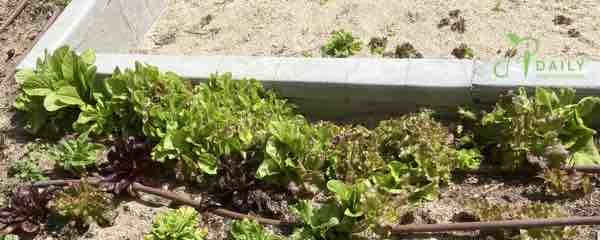What volunteer seedlings teach about cool season planting
One of the best ways to learn what you can plant BEFORE the last frost in the high desert of Idaho is to watch for volunteer seedlings. This would, of course, assume you had a garden in the general area last year. Watching when and where volunteer seedlings germinate will give you insight into optimal conditions for a given plant.
In order to successfully identify volunteer seedlings you need to learn to recognize first leaves versus true leaves for most plants. This is true for seedlings such as cilantro, broccoli, sunflowers, and even spinach. (Note: I’m sticking to cool season plants for this discussion)

Sometimes it’s just a matter of thinking on a smaller scale, such as with lettuce or peas. The first leaves of lettuce tend to be quite tiny compared to what the leaf size will be at maturity. Peas are scrunched up and don’t necessarily look like a plant until they get up out of the ground more.
To help you learn to identify volunteer seedlings, I’m going to share a few photos of what is sprouting in my garden right now. This is in spite of an extremely cold and winter like week last week.
I will go in order of earliest to most recent seedlings:
Lettuce – even with snow having covered my early lettuce sprouts when they were small, has grown in thick masses in a few places. This includes the chicken pen, where the new chicks were confined to the coop, but as soon as I was finally able to let them out a couple days ago devastated the lettuce patch by the coop door. Mmmm, fresh salad!

I don’t have photo where it is easy to see the small lettuces, but you can see the small ones in the video. I would like to point out that the volunteers are bunched next to the wall of the raised bed, while those I grew in the greenhouse are not much bigger. However, we did eat quite a few leaves of the greenhouse lettuce before I planted it out a couple of weeks ago.

AFTER gradually hardening off the greenhouse lettuce! Even though it is happy in cooler weather, it would still be shocked, likely to death, if I took it straight from greenhouse living to in the great outdoors. The leaves grow according to the environment.
Cilantro – has been sprouting excessively almost as long as the lettuce. I’ve always thought this ironic, since my husband wants to eat cilantro with tomatoes, which are a warm weather plant. (I think cilantro tastes like soap).
First leaves on cilantro are long and narrow, at the top of a slender stem, hardly a quarter inch off the ground. They can look a lot like grass sprouts.

I tend to let the cilantro grow where it will when it volunteers, as it has a very fast life cycle once things get a bit warmer. And it is very easy to pull if I decide later it is in the way.
Spinach – volunteers have been sporadic, but I had a very small patch of spinach and only left one plant to go to seed last year. The seedlings look very much like cilantro seedlings right at first. (You can see them in the video)
Sunflowers – may surprise you, especially given that the name makes a person think of warmth. However, I have observed sunflowers sprouting consistently in late March to early April. This means two things to me.
One, the sunflower seeds are not harmed by cold weather. And, two, they prefer to sprout when it is cooler. I know that almost every seed packet tells you to wait until after the last frost date. This is a mystery to me. Sunflowers are a perfect example of how volunteers can teach you about seed sprouting in your own climate.

Peas – were planted a bit later than I would prefer, so are not technically volunteers in my garden. However, the fact that they are robustly sprouting right on the heels of our mini ice-age in the middle of April is instructive.
Broccoli – was planted on the same mid-late March day that the peas were and have just popped up in their row. Again, just following a week of icy winds and freezing rain.

Strawberries – were planted from crowns about two weeks before the wintery weather. To tell the truth, I was a bit worried about them. I know that strawberry plants live through the winter, but I was concerned the conditions were too harsh for a plant trying to take root.
So, I am thrilled to report that nearly every one of the 25 plants is actively growing and is a healthy color of green!

Onions – didn’t do well in my garden last year. The unusually early and long duration of over 100°F days kept them fairly puny and I just left them in the ground in the fall. I have done this before with some good results. They have grown more in the last month than they did all of last summer. Again, in spite of the cold weather. (see one representative onion in the photo with the cilantro.)
I’m not saying your onion seeds or sets will grow gangbusters this time of year, but the plants are obviously cold tolerant.
I would have planted beets and potatoes by now if I had all my irrigation set up in my raised beds. Also, I need to re-do the edging on the potato bed because the open panels let too much grass grow into it.
In the past, my potato plants have survived very cool temperatures, but I would have at least covered some of them when it was getting into the upper 20°F’s at night, just to make sure.
When summer heat arrives
Most plants on this list bolt or dry up when the summer heat hits, typically around mid June. You can sometimes grow fall crops if you start from seed in a cooler greenhouse, but the seeds won’t germinate well in the warmer late summer soil temperature.
With broccoli, the biggest problems I have maintaining the plants and harvesting until fall are 1) aphids, 2) cabbage moth caterpillars, 3) keeping the flower stalks trimmed even if we aren’t eating it all. If you can do that, broccoli can often produce into November.
Potato plants “die off” in mid to late summer, but will revive when the weather cools off. Since you can harvest potatoes whenever you like, I find it convenient to do when there is less foliage to fight. I never manage to find all the potatoes which is why I have taken to growing them in the same garden bed every year. They are a bear to weed if one gets going among another crop, so unless I have serious pest or disease problems, that is my approach.
Sunflowers stay beautiful for a long time, but it will be pretty obvious when the seeds are mature, if you are growing some to harvest. If the birds are eating them, they are ready!
Using the fall for negative testing
When the first solid frost comes in the fall, you will right away notice which plants are NOT frost hardy. Their leaves turn black. Their fruit gets icky. If this happens to a plant, do not plant it out in the cooler temperatures of spring.
But if it stays alive and even perks up with the next sunny day, you should consider experimenting with earlier spring planting. This will give you homegrown vegetables sooner and help you avoid disappointment when cool weather plants don’t do well in the heat.
But why are some plants okay with freezing temperature
If you want to learn why peas don’t freeze, but zucchini does, I recommend

This book manages to give a detailed, but very readable explanation of the biology of plants in ways I found both interesting and useful.
